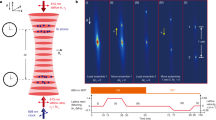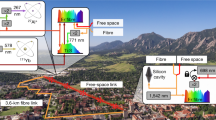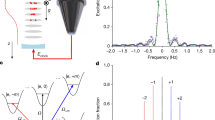Abstract
The accuracy of atomic clocks relies on the superb reproducibility of atomic spectroscopy, which is accomplished by careful control and the elimination of environmental perturbations on atoms. To date, individual atomic clocks have achieved a 10−18 level of total uncertainties1,2, but a two-clock comparison at the 10−18 level has yet to be demonstrated. Here, we demonstrate optical lattice clocks with 87Sr atoms interrogated in a cryogenic environment to address the blackbody radiation-induced frequency shift3, which remains the primary source of systematic uncertainty2,4,5,6 and has initiated vigorous theoretical7,8 and experimental9,10 investigations. The systematic uncertainty for the cryogenic clock is evaluated to be 7.2 × 10−18, which is expedited by operating two such cryo-clocks synchronously11,12. After 11 measurements performed over a month, statistical agreement between the two cryo-clocks reached 2.0 × 10−18. Such clocks' reproducibility is a major step towards developing accurate clocks at the low 10−18 level, and is directly applicable as a means for relativistic geodesy13.
This is a preview of subscription content, access via your institution
Access options
Subscribe to this journal
Receive 12 print issues and online access
$209.00 per year
only $17.42 per issue
Buy this article
- Purchase on Springer Link
- Instant access to full article PDF
Prices may be subject to local taxes which are calculated during checkout



Similar content being viewed by others
References
Chou, C. W., Hume, D. B., Koelemeij, J. C. J., Wineland, D. J. & Rosenband, T. Frequency comparison of two high-accuracy Al+ optical clocks. Phys. Rev. Lett. 104, 070802 (2010).
Bloom, B. J. et al. An optical lattice clock with accuracy and stability at the 10−18 level. Nature 506, 71–75 (2014).
Itano, W. M., Lewis, L. L. & Wineland, D. J. Shift of 2S1/2 hyperfine splittings due to blackbody radiation. Phys. Rev. A 25, 1233–1235 (1982).
Katori, H., Takamoto, M., Pal'chikov, V. G. & Ovsiannikov, V. D. Ultrastable optical clock with neutral atoms in an engineered light shift trap. Phys. Rev. Lett. 91, 173005 (2003).
Le Targat, R. et al. Experimental realization of an optical second with strontium lattice clocks. Nature Commun. 4, 2109 (2013).
Hinkley, N. et al. An atomic clock with 10−18 instability. Science 341, 1215–1218 (2013).
Porsev, S. G. & Derevianko, A. Multipolar theory of blackbody radiation shift of atomic energy levels and its implications for optical lattice clocks. Phys. Rev. A 74, 020502 (2006).
Safronova, M. S., Porsev, S. G., Safronova, U. I., Kozlov, M. G. & Clark, C. W. Blackbody-radiation shift in the Sr optical atomic clock. Phys. Rev. A 87, 012509 (2013).
Middelmann, T., Falke, S., Lisdat, C. & Sterr, U. High accuracy correction of blackbody radiation shift in an optical lattice clock. Phys. Rev. Lett. 109, 263004 (2012).
Sherman, J. A. et al. High-accuracy measurement of atomic polarizability in an optical lattice clock. Phys. Rev. Lett. 108, 153002 (2012).
Takamoto, M., Takano, T. & Katori, H. Frequency comparison of optical lattice clocks beyond the Dick limit. Nature Photon. 5, 288–292 (2011).
Nicholson, T. L. et al. Comparison of two independent Sr optical clocks with 1×10−17 stability at 103 s. Phys. Rev. Lett. 109, 230801 (2012).
Chou, C. W., Hume, D. B., Rosenband, T. & Wineland, D. J. Optical clocks and relativity. Science 329, 1630–1633 (2010).
Rosenband, T. et al. Frequency ratio of Al+ and Hg+ single-ion optical clocks; metrology at the 17th decimal place. Science 319, 1808–1812 (2008).
Dehmelt, H. G. Mono-ion oscillator as potential ultimate laser frequency standard. IEEE Trans. Instrum. Meas. IM-31, 83–87 (1982).
Huntemann, N. et al. High-accuracy optical clock based on the octupole transition in 171Yb+. Phys. Rev. Lett. 108, 090801 (2012).
Itano, W. M. et al. Quantum projection noise: population fluctuations in two-level systems. Phys. Rev. A 47, 3554–3570 (1993).
Katori, H. Optical lattice clocks and quantum metrology. Nature Photon. 5, 203–210 (2011).
Falke, S. et al. A strontium lattice clock with 3 × 10−17 inaccuracy and its frequency. New J. Phys. 16, 073023 (2014).
Westergaard, P. G. et al. Lattice-induced frequency shifts in Sr optical lattice clocks at the 10−17 level. Phys. Rev. Lett. 106, 210801 (2011).
Katori, H., Hashiguchi, K., Il'inova, E. Y. & Ovsiannikov, V. D. Magic wavelength to make optical lattice clocks insensitive to atomic motion. Phys. Rev. Lett. 103, 153004 (2009).
Lodewyck, J., Zawada, M., Lorini, L., Gurov, M. & Lemonde, P. Observation and cancellation of a perturbing DC stark shift in strontium optical lattice clocks. IEEE Trans. Ultrason. Ferroelectr. Freq. Control 59, 411–415 (2012).
Hachisu, H. et al. Trapping of neutral mercury atoms and prospects for optical lattice clocks. Phys. Rev. Lett. 100, 053001 (2008).
McFerran, J. et al. Neutral atom frequency reference in the deep ultraviolet with fractional uncertainty = 5.7 × 10−15. Phys. Rev. Lett. 108, 183004 (2012).
Derevianko, A., Dzuba, V. A. & Flambaum, V. V. Highly charged ions as a basis of optical atomic clockwork of exceptional accuracy. Phys. Rev. Lett. 109, 180801 (2012).
Mukaiyama, T., Katori, H., Ido, T., Li, Y. & Kuwata-Gonokami, M. Recoil-limited laser cooling of 87Sr atoms near the Fermi temperature. Phys. Rev. Lett. 90, 113002 (2003).
Takamoto, M. & Katori, H. Coherence of spin-polarized fermions interacting with a clock laser in a Stark-shift-free optical lattice. J. Phys. Soc. Jpn 78, 013301 (2009).
Takamoto, M. et al. Improved frequency measurement of a one-dimensional optical lattice clock with a spin-polarized fermionic 87Sr isotope. J. Phys. Soc. Jpn 75, 104302 (2006).
Akatsuka, T. et al. 30-km-long optical fiber link at 1397 nm for frequency comparison between distant strontium optical lattice clocks. Jpn J. Appl. Phys. 53, 032801 (2014).
Yamaguchi, A. et al. Direct comparison of distant optical lattice clocks at the 10−16 uncertainty. Appl. Phys. Exp. 4, 082203 (2011).
Middelmann, T. et al. Tackling the blackbody shift in a strontium optical lattice clock. IEEE Trans. Instrum. Meas. 60, 2550–2557 (2011).
Acknowledgements
This work received partial support from the Japan Society for the Promotion of Science (JSPS) through its Funding Program for World-Leading Innovative R&D on Science and Technology (FIRST) and from the Photon Frontier Network Program of the Ministry of Education, Culture, Sports, Science and Technology (MEXT), Japan. The authors thank H. Kubo for his contribution in the initial stage of the experiments, and N. Nemitz, T. Takano, A. Yamaguchi and N. Ohmae for useful comments and conversations.
Author information
Authors and Affiliations
Contributions
H.K. envisaged and initiated experiments. H.K., M.T., M.D., T.O. and I.U. designed the apparatus and experiments. I.U. and M.T. carried out experiments and analysed data. I.U., M.T., M.D. and H.K. discussed the results and contributed to writing the draft manuscript.
Corresponding author
Ethics declarations
Competing interests
The authors declare no competing financial interests.
Supplementary information
Supplementary information
Supplementary information (PDF 288 kb)
Rights and permissions
About this article
Cite this article
Ushijima, I., Takamoto, M., Das, M. et al. Cryogenic optical lattice clocks. Nature Photon 9, 185–189 (2015). https://doi.org/10.1038/nphoton.2015.5
Received:
Accepted:
Published:
Issue Date:
DOI: https://doi.org/10.1038/nphoton.2015.5
This article is cited by
-
Collectively enhanced Ramsey readout by cavity sub- to superradiant transition
Nature Communications (2024)
-
COMPASSO mission and its iodine clock: outline of the clock design
GPS Solutions (2024)
-
GET 1-2022 State Primary Standard for time and frequency units and the national time scale: contribution to the Coordinated Universal Time
Measurement Techniques (2024)
-
Long-lived Bell states in an array of optical clock qubits
Nature Physics (2022)
-
Microgravity Test Complex for Mobile and Portable Optical Frequency Standards
Measurement Techniques (2022)



